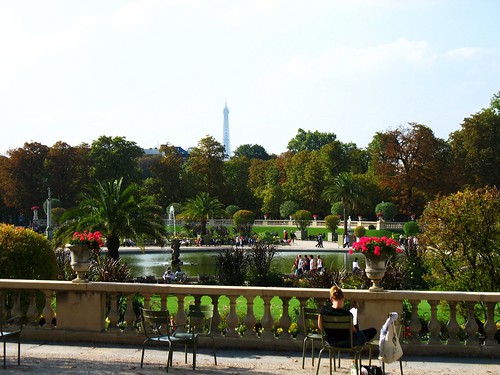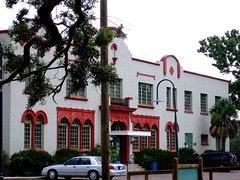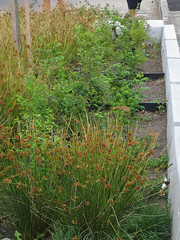In improving communities, small steps can make a big difference

Posted October 29, 2009 at 1:12PM
Last week, I had the honor of speaking to the Indiana chapter of the American Society of Landscape Architects on the subject of sustainable communities. I enjoy this sort of thing, and when I have time - as I did last week - one of the things I like to do is to show how sustainability can be furthered on a range of scales. In Indiana I went through about a dozen examples, moving from large-scale metropolitan planning (I used the Sacramento Blueprint) to downtown planning (Raleigh) all the way down to Habitat for Humanity's wonderful re-orientation of and addition to a modest trailer park in Charlottesville.
We make a mistake if we elect to see any one of these scales as "the" solution. While I think of myself as an advocate for strong, visionary metropolitan planning (the "holy grail of smart growth," I told my Indiana audience) or even "megaregional" planning, if we fail to take the right, sometimes small, steps close to the ground, we will not succeed in creating better places and communities. In fact, we will do the opposite by hurting the popularity and replicability of our bigger schemes.
Andrew Manshel of the Greater Jamaica (N.Y.) Development Corporation is a spokesman for using small changes to make a big difference in sustainable urban revitalization. Previously one of the principals behind the hugely successful rebirth of Bryant Park in New York City, 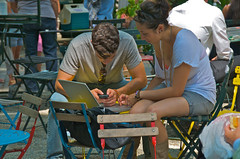 Manshel cites the simple decision to provide movable chairs (based on those in Paris's wonderful Jardin du Luxembourg, above) as one of the keys to Bryant Park's popularity:
Manshel cites the simple decision to provide movable chairs (based on those in Paris's wonderful Jardin du Luxembourg, above) as one of the keys to Bryant Park's popularity:
"People like to control their own space, and movable chairs allow them to do just that. Movable chairs let people face one another and interact in different ways, not just the ones that landscape designers have in mind when they arrange fixed furniture. Having chairs scattered around sends a message of trust that people won't steal them. And chairs' historical associations convey the sense that a space is civilized and of high quality-like the European areas that use them, such as the Luxembourg Gardens in Paris . . .
"Some regarded [the] suggestion as naive; failing to tie down chairs amid the bustle and grunge of 42nd Street would surely spell trouble, they said. But the chairs-the same model used in the Luxembourg Gardens-were a key element of Bryant Park's hugely successful reintroduction in 1992. One now finds movable chairs in public spaces across the country . . ."
The quote is from Manshel's provocative article, "A Place Is Better than a Plan," in City Journal, published by the Manhattan Institute. Manshel believes that the importance of small ideas to urban revitalization is not sufficiently recognized. He cites grand schemes that have failed (Detroit's Renaissance Center, the park above Boston's Big Dig) largely because they neglected the small, human-scale elements that make a place lovable to people.
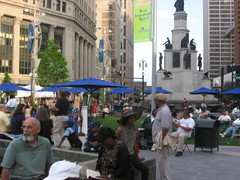 By contrast, Manshel cites Detroit's Campus Martius (see photo) as a highly successful and popular public space - the kind of public amenity that improves its surroundings - because it includes human touches such as movable chairs, a fountain, food concessions, regular arts programming, and high-quality horticulture. Manshel notes that small changes also have numerous practical advantages:
By contrast, Manshel cites Detroit's Campus Martius (see photo) as a highly successful and popular public space - the kind of public amenity that improves its surroundings - because it includes human touches such as movable chairs, a fountain, food concessions, regular arts programming, and high-quality horticulture. Manshel notes that small changes also have numerous practical advantages:
"They're cheap, for one thing. Also, what works can be easily expanded, and what doesn't work can be as easily terminated or altered. One successful food concession can become two; an unsuccessful stall selling local crafts can be replaced; a planter made from a material that discolors or chips can be replaced with a better one. Contrast that with grand schemes, which can attract broad opposition and be subject to complex political, logistical, and financial obstacles. Once an elaborate design has been committed to, backing away from it-or even altering it-becomes both politically and mechanically complicated. Further, planners have a limited capacity to predict how people will respond to their designs. The larger the project, the more likely unintended consequences become, and the more difficult it is to change course."
 Manshel's primary subject matter is parks and civic spaces, of course, not small-scale trailer park improvements, but I think he may be on to a concept that has broader application. Look at the inspiring community improvement and housing provided by a small-scale undertaking like Project Row Houses in Houston, which surely would have been entangled in all sorts of legal and political red tape were it first proposed on a larger urban scale.
Manshel's primary subject matter is parks and civic spaces, of course, not small-scale trailer park improvements, but I think he may be on to a concept that has broader application. Look at the inspiring community improvement and housing provided by a small-scale undertaking like Project Row Houses in Houston, which surely would have been entangled in all sorts of legal and political red tape were it first proposed on a larger urban scale.
The city of Toronto has embraced small-scale improvements through its Clean and Beautiful City programs, which provide small grants to neighborhood associations for community projects undertaken primarily by volunteers. The idea is to catalyze pilot projects that can showcase "green and efficient city-building techniques of the future." Grantees have improved paths and bridges, built permeable surfaces for stormwater management, created public art, and planted community gardens, among other things (examples here). An additional benefit of some projects is skills training for neighborhood youth.
Even the federal government has a role in promoting beneficial small changes. One of the most popular transportation reforms of the seminal "ISTEA" legislation of 1991 was the Transportation Enhancements program, which continues to provide grants for community-based and -scaled projects related to transportation. Eligible categories include walking and cycling facilities, scenic easements, historic preservation, restoration of historic transportation facilities (see photo of rehabbed train station in Bay St. Louis, MS), environmental mitigation (see photo of street green infrastructure in Portland), and others. If you have a cycling trail of significant length built in your community in the last couple of decades, chances are that the Transportation Enhancements program helped fund it.
I don't know that I would go so far as to say that a great place "is better than" a plan, if for no other reason than planning can be great, too, and help bring better places to more people and regions. But small elements of placemaking allow us to discover and improve what works, with, as Manshel suggests, a minimum of obstacles and risk. Recognizing that is an important building block of sustainability.
